Leadership Workbook Assessment: BSBMGT605 - Unit Requirements
VerifiedAdded on 2021/02/20
|52
|12919
|199
Homework Assignment
AI Summary
This document outlines the assessment criteria for the BSBMGT605 unit, focusing on providing leadership across an organization. It details the elements of competency, including communicating organizational goals, influencing groups, building teams, and demonstrating personal and professional competence. The document specifies performance evidence, foundation skills, and knowledge evidence required for competency. It also includes assessment conditions, definitions of assessment tools (Learner Guide, Workbook Activities, Observation/Demonstration, Skills and Knowledge Activity, and Major Activity), and an observation/demonstration checklist. The assessment emphasizes practical application, requiring learners to demonstrate skills in communication, influence, team building, and ethical conduct. The document is designed to guide students through the assessment process, ensuring they meet the required standards for the unit.
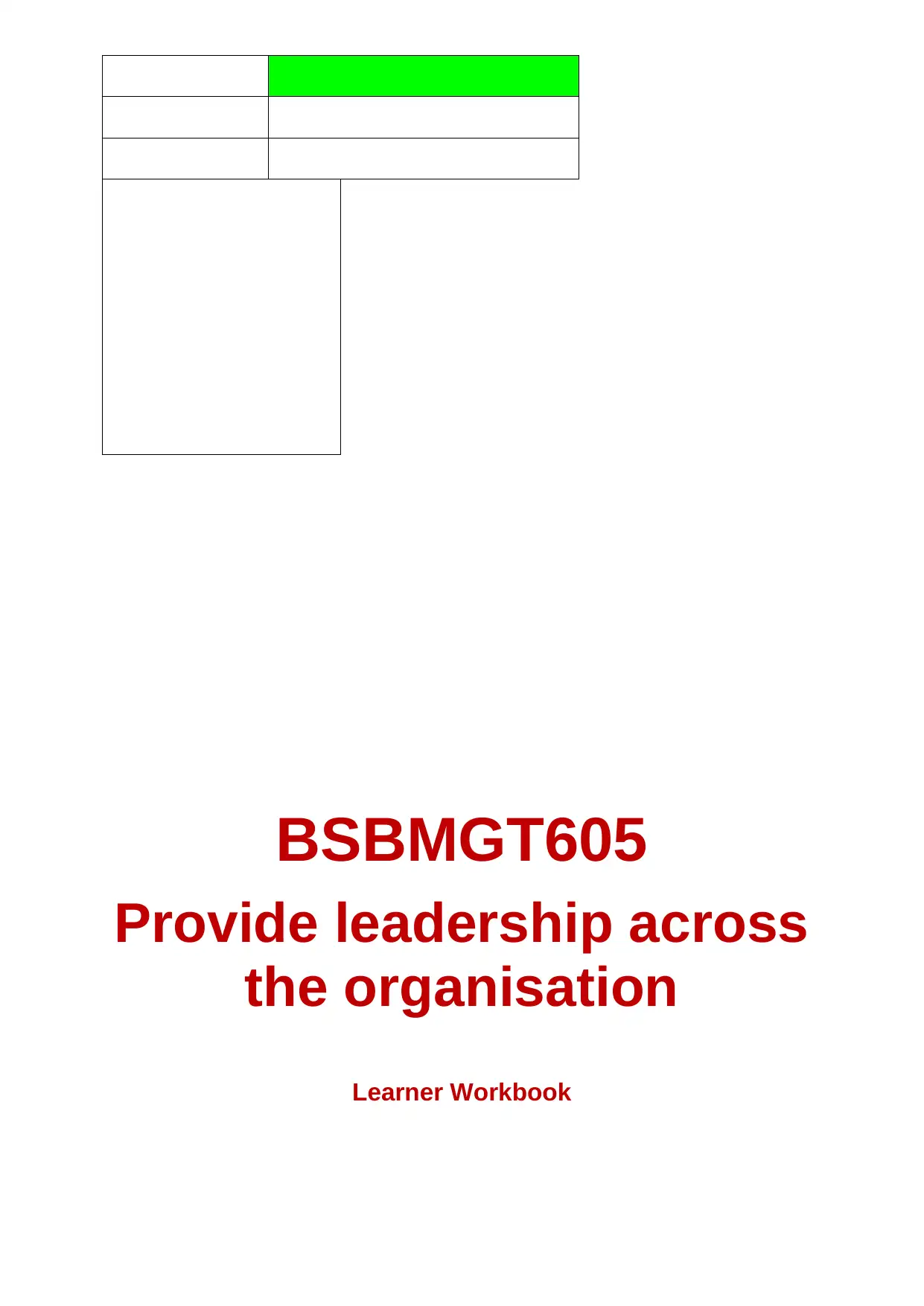
BSBMGT605
Provide leadership across
the organisation
Learner Workbook
Provide leadership across
the organisation
Learner Workbook
Paraphrase This Document
Need a fresh take? Get an instant paraphrase of this document with our AI Paraphraser
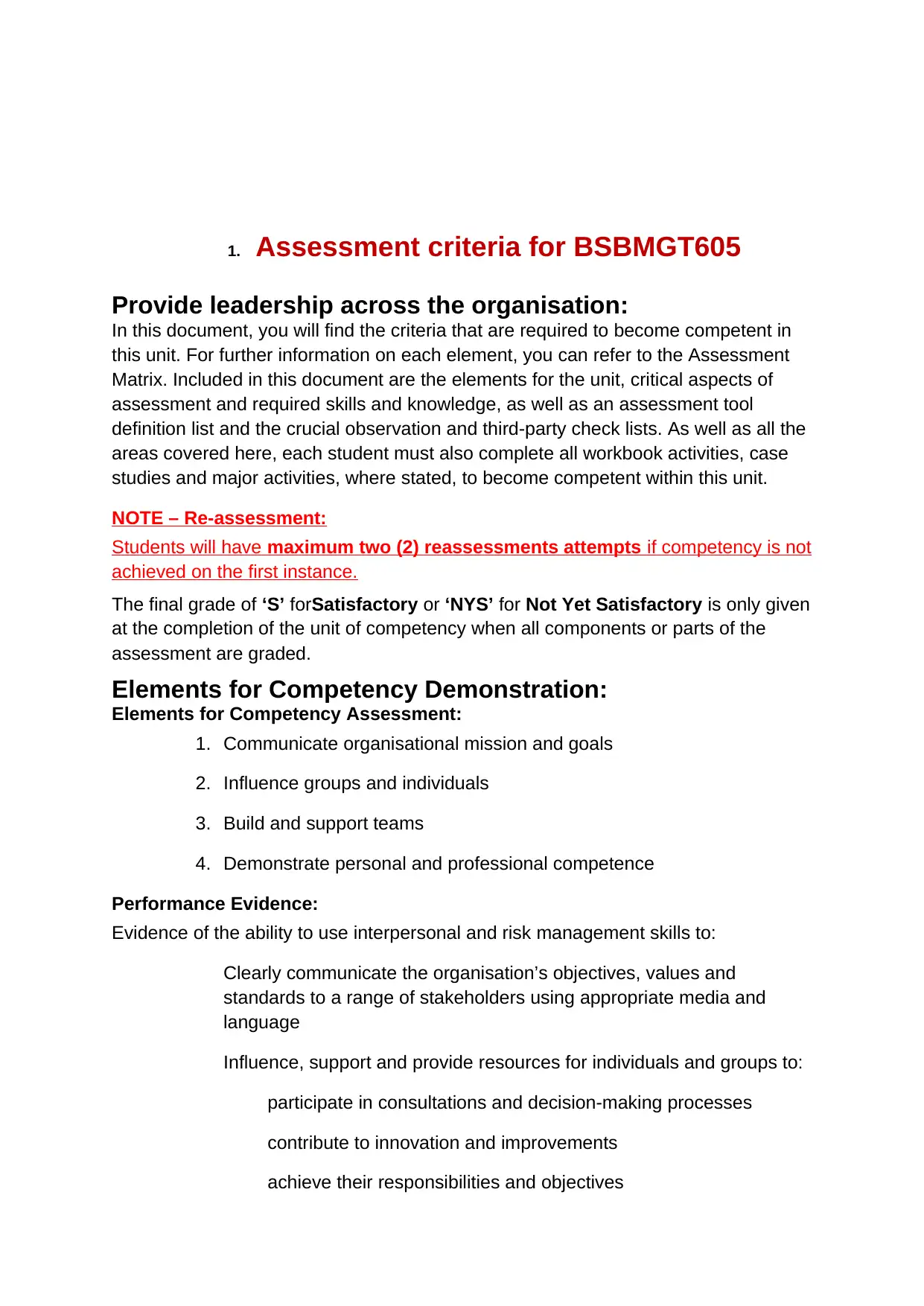
1. Assessment criteria for BSBMGT605
Provide leadership across the organisation:
In this document, you will find the criteria that are required to become competent in
this unit. For further information on each element, you can refer to the Assessment
Matrix. Included in this document are the elements for the unit, critical aspects of
assessment and required skills and knowledge, as well as an assessment tool
definition list and the crucial observation and third-party check lists. As well as all the
areas covered here, each student must also complete all workbook activities, case
studies and major activities, where stated, to become competent within this unit.
NOTE – Re-assessment:
Students will have maximum two (2) reassessments attempts if competency is not
achieved on the first instance.
The final grade of ‘S’ forSatisfactory or ‘NYS’ for Not Yet Satisfactory is only given
at the completion of the unit of competency when all components or parts of the
assessment are graded.
Elements for Competency Demonstration:
Elements for Competency Assessment:
1. Communicate organisational mission and goals
2. Influence groups and individuals
3. Build and support teams
4. Demonstrate personal and professional competence
Performance Evidence:
Evidence of the ability to use interpersonal and risk management skills to:
Clearly communicate the organisation’s objectives, values and
standards to a range of stakeholders using appropriate media and
language
Influence, support and provide resources for individuals and groups to:
participate in consultations and decision-making processes
contribute to innovation and improvements
achieve their responsibilities and objectives
Provide leadership across the organisation:
In this document, you will find the criteria that are required to become competent in
this unit. For further information on each element, you can refer to the Assessment
Matrix. Included in this document are the elements for the unit, critical aspects of
assessment and required skills and knowledge, as well as an assessment tool
definition list and the crucial observation and third-party check lists. As well as all the
areas covered here, each student must also complete all workbook activities, case
studies and major activities, where stated, to become competent within this unit.
NOTE – Re-assessment:
Students will have maximum two (2) reassessments attempts if competency is not
achieved on the first instance.
The final grade of ‘S’ forSatisfactory or ‘NYS’ for Not Yet Satisfactory is only given
at the completion of the unit of competency when all components or parts of the
assessment are graded.
Elements for Competency Demonstration:
Elements for Competency Assessment:
1. Communicate organisational mission and goals
2. Influence groups and individuals
3. Build and support teams
4. Demonstrate personal and professional competence
Performance Evidence:
Evidence of the ability to use interpersonal and risk management skills to:
Clearly communicate the organisation’s objectives, values and
standards to a range of stakeholders using appropriate media and
language
Influence, support and provide resources for individuals and groups to:
participate in consultations and decision-making processes
contribute to innovation and improvements
achieve their responsibilities and objectives

P a g e | 3
Facilitate consultative decision-making processes with relevant internal
and external stakeholders
Demonstrate ethical conduct and professional competence and
continuing professional development
Encourage others to adopt business ethics and build their commitment
to the organisation
Foundation Skills:
Learning
Actively looks for and accepts ways to maintain and improve own skills
and knowledge
Reading
Evaluates and integrates facts and ideas to construct meaning from a
range of text types
Writing
Records and reports key information related to the outcomes of the job
to interact effectively and appropriately with the team
Researches, plans and prepares documentation using format and
language appropriate to the audience
Oral communication
Participates in a variety of spoken exchanges with clients, co-workers
and stakeholders using structure and language appropriate to context
and audience
Navigate the world of work
Works autonomously making high level decisions related to the
achievement of organisational goals
Reflects on designation of roles and responsibilities and how
everyone’s role contributes to broader organisational goals
Appreciates the implications of ethical and other organisational
responsibilities in carrying out own role
Interact with others
Demonstrates sophisticated control over oral, visual and/or written
formats, drawing on a range of communication practices to achieve
goals
Facilitate consultative decision-making processes with relevant internal
and external stakeholders
Demonstrate ethical conduct and professional competence and
continuing professional development
Encourage others to adopt business ethics and build their commitment
to the organisation
Foundation Skills:
Learning
Actively looks for and accepts ways to maintain and improve own skills
and knowledge
Reading
Evaluates and integrates facts and ideas to construct meaning from a
range of text types
Writing
Records and reports key information related to the outcomes of the job
to interact effectively and appropriately with the team
Researches, plans and prepares documentation using format and
language appropriate to the audience
Oral communication
Participates in a variety of spoken exchanges with clients, co-workers
and stakeholders using structure and language appropriate to context
and audience
Navigate the world of work
Works autonomously making high level decisions related to the
achievement of organisational goals
Reflects on designation of roles and responsibilities and how
everyone’s role contributes to broader organisational goals
Appreciates the implications of ethical and other organisational
responsibilities in carrying out own role
Interact with others
Demonstrates sophisticated control over oral, visual and/or written
formats, drawing on a range of communication practices to achieve
goals
⊘ This is a preview!⊘
Do you want full access?
Subscribe today to unlock all pages.

Trusted by 1+ million students worldwide

Identifies strengths and limitations of own interpersonal skills and
addresses areas that would benefit from further development
Recognises the importance of building rapport to establish effective
working relationships and inspire trust and confidence
Collaborates and cooperates with others, playing an active role in
leading and facilitating effective group interaction and influencing
direction
Facilitates a climate in which others feel comfortable to identify, explore
and build on a variety of perspectives to achieve shared outcomes
Get the work done
Accepts responsibility for planning and sequencing complex tasks and
workload of self and others, negotiating key aspects with others
considering capabilities, efficiencies and effectiveness
Applies problem solving processes to identify risks, evaluate options
and determine solutions
Facilitates a climate in which creativity and innovation are accepted as
an integral part of achieving outcomes
Actively identifies systems, devices and applications with potential to
meet current and/or future needs
Knowledge Evidence:
To complete the unit requirements safely and effectively, the individual must:
Explain business ethics and their application to leadership
Outline leadership styles and their application in supporting the
organisation’s mission, objectives and values
Explain the impact of legislation in providing leadership in the
organisation
Explain the organisation’s mission, purpose and values
Describe organisation objectives, plans and strategies
Explain organisational change processes
Assessment Conditions:
Assessment must be conducted in a safe environment where evidence gathered
demonstrates consistent performance of typical activities experienced in the
management and leadership field of work and include access to:
addresses areas that would benefit from further development
Recognises the importance of building rapport to establish effective
working relationships and inspire trust and confidence
Collaborates and cooperates with others, playing an active role in
leading and facilitating effective group interaction and influencing
direction
Facilitates a climate in which others feel comfortable to identify, explore
and build on a variety of perspectives to achieve shared outcomes
Get the work done
Accepts responsibility for planning and sequencing complex tasks and
workload of self and others, negotiating key aspects with others
considering capabilities, efficiencies and effectiveness
Applies problem solving processes to identify risks, evaluate options
and determine solutions
Facilitates a climate in which creativity and innovation are accepted as
an integral part of achieving outcomes
Actively identifies systems, devices and applications with potential to
meet current and/or future needs
Knowledge Evidence:
To complete the unit requirements safely and effectively, the individual must:
Explain business ethics and their application to leadership
Outline leadership styles and their application in supporting the
organisation’s mission, objectives and values
Explain the impact of legislation in providing leadership in the
organisation
Explain the organisation’s mission, purpose and values
Describe organisation objectives, plans and strategies
Explain organisational change processes
Assessment Conditions:
Assessment must be conducted in a safe environment where evidence gathered
demonstrates consistent performance of typical activities experienced in the
management and leadership field of work and include access to:
Paraphrase This Document
Need a fresh take? Get an instant paraphrase of this document with our AI Paraphraser

P a g e | 5
Relevant legislation, regulation, standards and codes
Relevant workplace documentation and resources
Case studies and, where possible, real situations
Interaction with others
Assessors must satisfy NVR/AQTF assessor requirements.
Links:
Companion volumes available from the IBSA website:
http://www.ibsa.org.au/companion_volumes -
http://www.ibsa.org.au/companion_volumes
Any observations and practical assessments must be recorded in the observation
checklist. All practical tasks should be demonstrated during the length of the course.
As the instructor you must maintain a record demonstrating the date of the practical
activities and any comments relevant to the performance of each student. Where a
student is not able to demonstrate competence in a practical observation activity,
further questioning should be put in its place.As the instructor, you could be
assessing the student’s literacy, numeracy and language skills, as well as the
content and context of his/her answers.In some cases, you will have to adjust and
amend the assessment tools, using different and varied methods (such as oral
assessment), to allow students to be assessed according to their needs and abilities.
Assessment Tool Definitions:
Assessment Tool How is it used? What is it?
Learner Guide
(To be used as an informational
guide)
The Learner Guide links with the Learner
Workbook as it provides the information
given during sessions and more. It can help
students to further their knowledge and to
also complete the activities.
Learner Workbook Activities
(Entire completion is required)
Each student should be given a Learner
Workbook which will hold several activities,
both formative and summative, that all need
to be completed in conjunction with the
appropriate sessions. The PowerPoint,
Learner Guide and instructor should provide
further information to help with the activities.
Observation/Demonstration
(To be completed for each numbered
point as stated on the checklist)
An observation should be completed for each
of the students by the instructor. If the tasks
aren’t everyday actions, a simulated
environment is acceptable, or a
demonstration can be set up. An observation
checklist can be found at the end of this
document.
Skills and Knowledge Activity
(Entire completion is required)
A Skills and Knowledge Activity is a
summative assessment and is found before
the Major Activity in the Learner Workbook.
This should take between 1-2 hours and
Relevant legislation, regulation, standards and codes
Relevant workplace documentation and resources
Case studies and, where possible, real situations
Interaction with others
Assessors must satisfy NVR/AQTF assessor requirements.
Links:
Companion volumes available from the IBSA website:
http://www.ibsa.org.au/companion_volumes -
http://www.ibsa.org.au/companion_volumes
Any observations and practical assessments must be recorded in the observation
checklist. All practical tasks should be demonstrated during the length of the course.
As the instructor you must maintain a record demonstrating the date of the practical
activities and any comments relevant to the performance of each student. Where a
student is not able to demonstrate competence in a practical observation activity,
further questioning should be put in its place.As the instructor, you could be
assessing the student’s literacy, numeracy and language skills, as well as the
content and context of his/her answers.In some cases, you will have to adjust and
amend the assessment tools, using different and varied methods (such as oral
assessment), to allow students to be assessed according to their needs and abilities.
Assessment Tool Definitions:
Assessment Tool How is it used? What is it?
Learner Guide
(To be used as an informational
guide)
The Learner Guide links with the Learner
Workbook as it provides the information
given during sessions and more. It can help
students to further their knowledge and to
also complete the activities.
Learner Workbook Activities
(Entire completion is required)
Each student should be given a Learner
Workbook which will hold several activities,
both formative and summative, that all need
to be completed in conjunction with the
appropriate sessions. The PowerPoint,
Learner Guide and instructor should provide
further information to help with the activities.
Observation/Demonstration
(To be completed for each numbered
point as stated on the checklist)
An observation should be completed for each
of the students by the instructor. If the tasks
aren’t everyday actions, a simulated
environment is acceptable, or a
demonstration can be set up. An observation
checklist can be found at the end of this
document.
Skills and Knowledge Activity
(Entire completion is required)
A Skills and Knowledge Activity is a
summative assessment and is found before
the Major Activity in the Learner Workbook.
This should take between 1-2 hours and
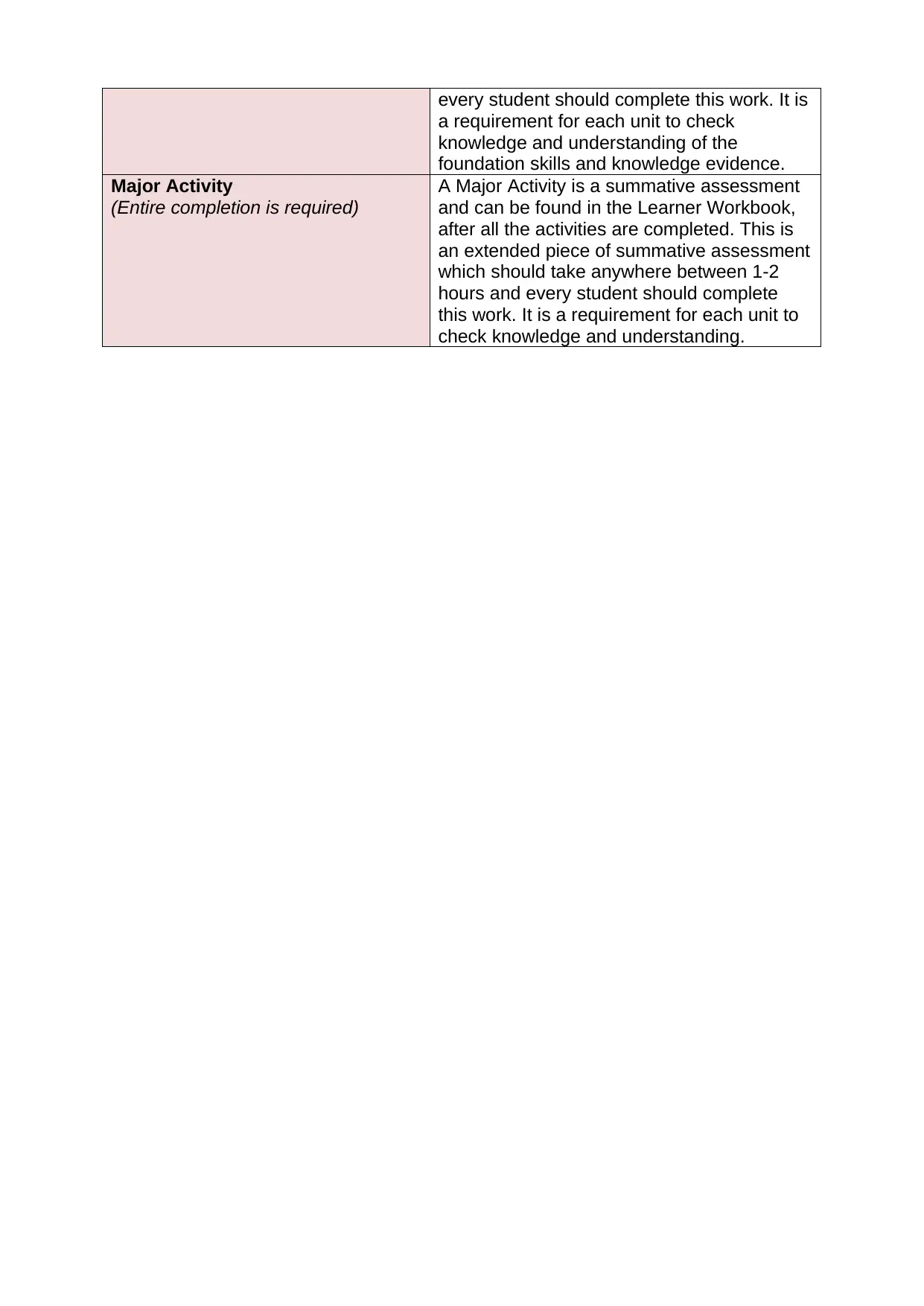
every student should complete this work. It is
a requirement for each unit to check
knowledge and understanding of the
foundation skills and knowledge evidence.
Major Activity
(Entire completion is required)
A Major Activity is a summative assessment
and can be found in the Learner Workbook,
after all the activities are completed. This is
an extended piece of summative assessment
which should take anywhere between 1-2
hours and every student should complete
this work. It is a requirement for each unit to
check knowledge and understanding.
a requirement for each unit to check
knowledge and understanding of the
foundation skills and knowledge evidence.
Major Activity
(Entire completion is required)
A Major Activity is a summative assessment
and can be found in the Learner Workbook,
after all the activities are completed. This is
an extended piece of summative assessment
which should take anywhere between 1-2
hours and every student should complete
this work. It is a requirement for each unit to
check knowledge and understanding.
⊘ This is a preview!⊘
Do you want full access?
Subscribe today to unlock all pages.

Trusted by 1+ million students worldwide
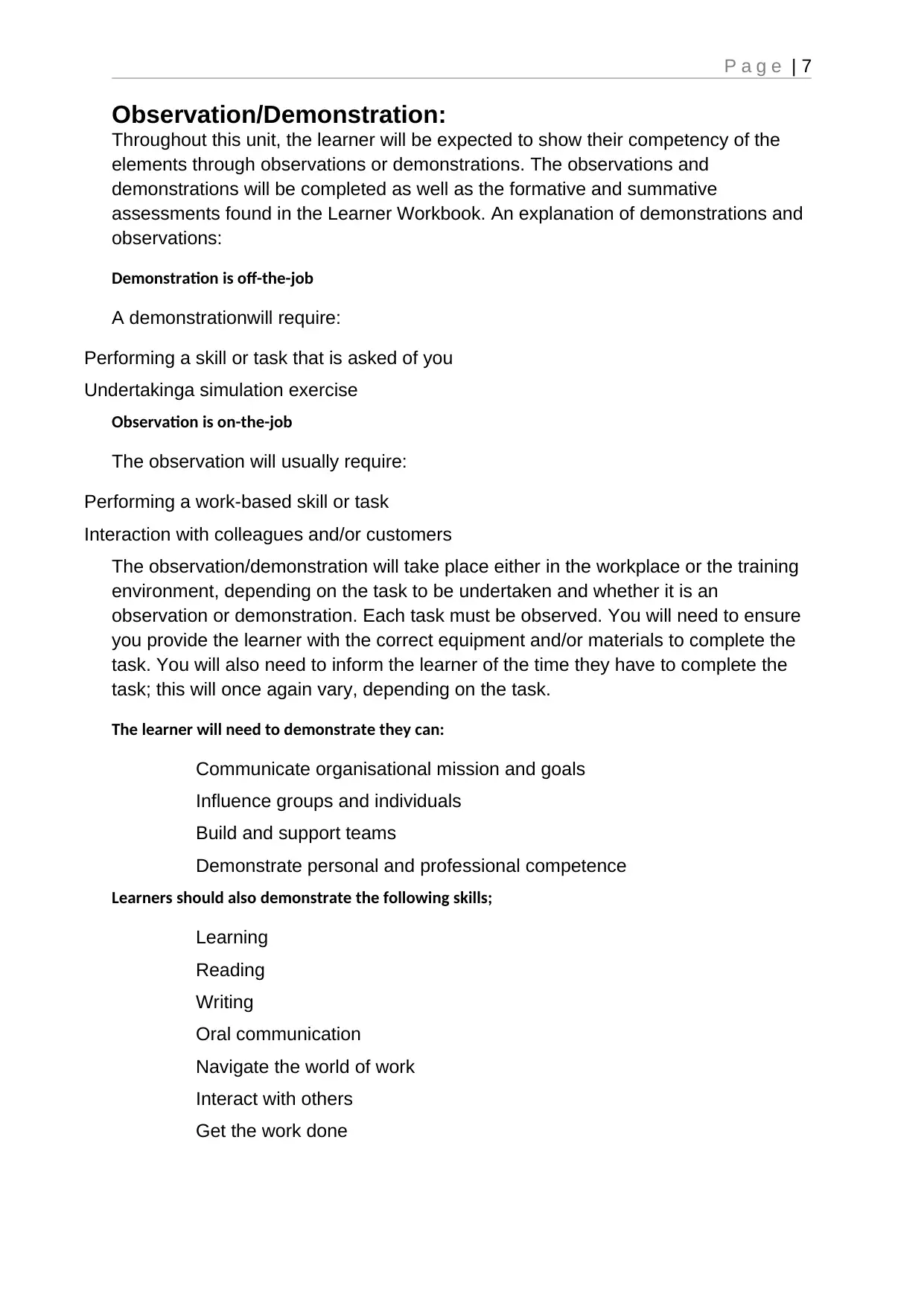
P a g e | 7
Observation/Demonstration:
Throughout this unit, the learner will be expected to show their competency of the
elements through observations or demonstrations. The observations and
demonstrations will be completed as well as the formative and summative
assessments found in the Learner Workbook. An explanation of demonstrations and
observations:
Demonstration is off-the-job
A demonstrationwill require:
Performing a skill or task that is asked of you
Undertakinga simulation exercise
Observation is on-the-job
The observation will usually require:
Performing a work-based skill or task
Interaction with colleagues and/or customers
The observation/demonstration will take place either in the workplace or the training
environment, depending on the task to be undertaken and whether it is an
observation or demonstration. Each task must be observed. You will need to ensure
you provide the learner with the correct equipment and/or materials to complete the
task. You will also need to inform the learner of the time they have to complete the
task; this will once again vary, depending on the task.
The learner will need to demonstrate they can:
Communicate organisational mission and goals
Influence groups and individuals
Build and support teams
Demonstrate personal and professional competence
Learners should also demonstrate the following skills;
Learning
Reading
Writing
Oral communication
Navigate the world of work
Interact with others
Get the work done
Observation/Demonstration:
Throughout this unit, the learner will be expected to show their competency of the
elements through observations or demonstrations. The observations and
demonstrations will be completed as well as the formative and summative
assessments found in the Learner Workbook. An explanation of demonstrations and
observations:
Demonstration is off-the-job
A demonstrationwill require:
Performing a skill or task that is asked of you
Undertakinga simulation exercise
Observation is on-the-job
The observation will usually require:
Performing a work-based skill or task
Interaction with colleagues and/or customers
The observation/demonstration will take place either in the workplace or the training
environment, depending on the task to be undertaken and whether it is an
observation or demonstration. Each task must be observed. You will need to ensure
you provide the learner with the correct equipment and/or materials to complete the
task. You will also need to inform the learner of the time they have to complete the
task; this will once again vary, depending on the task.
The learner will need to demonstrate they can:
Communicate organisational mission and goals
Influence groups and individuals
Build and support teams
Demonstrate personal and professional competence
Learners should also demonstrate the following skills;
Learning
Reading
Writing
Oral communication
Navigate the world of work
Interact with others
Get the work done
Paraphrase This Document
Need a fresh take? Get an instant paraphrase of this document with our AI Paraphraser

Observation/Demonstration Checklist:
Unit of Competence
(Code and Title)
BSBMGT605 Provide
leadership across the
organisation
Demonstration
Tasks
Completed
Materials and
Equipment
Provided
Tasks to be observed, demonstrated or simulated
if appropriate
Yes No Comment
1. Communicate organisational mission and
goals: Did the learner demonstrate they could
clarify objectives, values and standards in
accordance with organisation's strategic direction?
2. Communicate organisational mission and
goals: Did the learner demonstrate they could
establish linkages between organisational
objectives, values and standards and the
responsibilities of relevant groups and individuals?
3. Communicate organisational mission and
goals: Did the learner demonstrate they could
ensure media and language used is appropriate to
individuals and group circumstances?
4. Communicate organisational mission and
goals: Did the learner demonstrate they could state
clear expectations of internal groups and individuals
and explain in a manner which builds commitment
to the organisation?
5. Communicate organisational mission and
goals: Did the learner demonstrate they could
address expectations of the organisation?
6. Communicate organizational mission and goals: Did the
learner demonstrate they could investigate incidents
promptly and communicate results clearly to relevant groups
and individuals?
7. Influence groups and individuals:Did the learner
demonstrate they could build trust, confidence and
Unit of Competence
(Code and Title)
BSBMGT605 Provide
leadership across the
organisation
Demonstration
Tasks
Completed
Materials and
Equipment
Provided
Tasks to be observed, demonstrated or simulated
if appropriate
Yes No Comment
1. Communicate organisational mission and
goals: Did the learner demonstrate they could
clarify objectives, values and standards in
accordance with organisation's strategic direction?
2. Communicate organisational mission and
goals: Did the learner demonstrate they could
establish linkages between organisational
objectives, values and standards and the
responsibilities of relevant groups and individuals?
3. Communicate organisational mission and
goals: Did the learner demonstrate they could
ensure media and language used is appropriate to
individuals and group circumstances?
4. Communicate organisational mission and
goals: Did the learner demonstrate they could state
clear expectations of internal groups and individuals
and explain in a manner which builds commitment
to the organisation?
5. Communicate organisational mission and
goals: Did the learner demonstrate they could
address expectations of the organisation?
6. Communicate organizational mission and goals: Did the
learner demonstrate they could investigate incidents
promptly and communicate results clearly to relevant groups
and individuals?
7. Influence groups and individuals:Did the learner
demonstrate they could build trust, confidence and
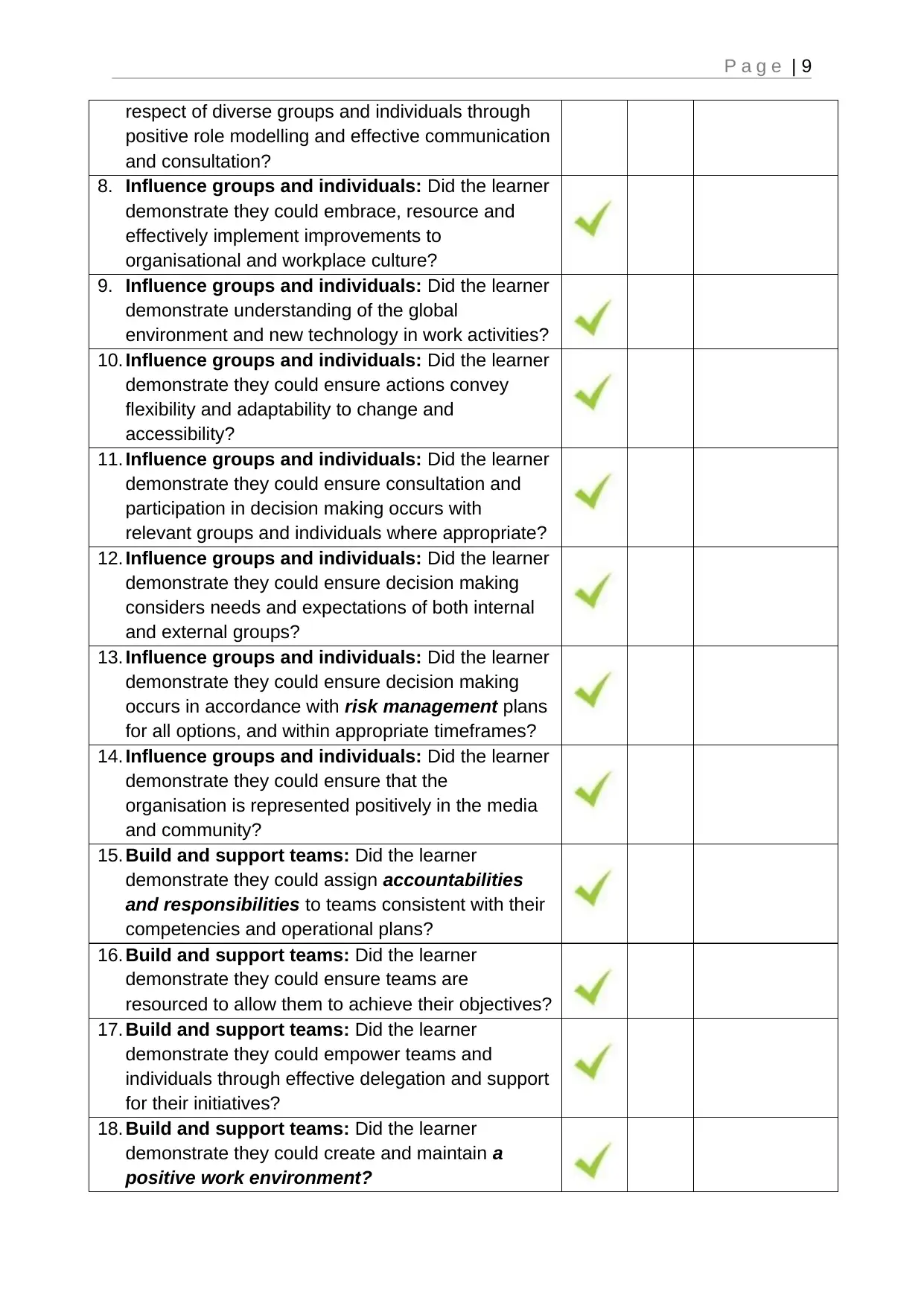
P a g e | 9
respect of diverse groups and individuals through
positive role modelling and effective communication
and consultation?
8. Influence groups and individuals: Did the learner
demonstrate they could embrace, resource and
effectively implement improvements to
organisational and workplace culture?
9. Influence groups and individuals: Did the learner
demonstrate understanding of the global
environment and new technology in work activities?
10. Influence groups and individuals: Did the learner
demonstrate they could ensure actions convey
flexibility and adaptability to change and
accessibility?
11. Influence groups and individuals: Did the learner
demonstrate they could ensure consultation and
participation in decision making occurs with
relevant groups and individuals where appropriate?
12. Influence groups and individuals: Did the learner
demonstrate they could ensure decision making
considers needs and expectations of both internal
and external groups?
13. Influence groups and individuals: Did the learner
demonstrate they could ensure decision making
occurs in accordance with risk management plans
for all options, and within appropriate timeframes?
14. Influence groups and individuals: Did the learner
demonstrate they could ensure that the
organisation is represented positively in the media
and community?
15. Build and support teams: Did the learner
demonstrate they could assign accountabilities
and responsibilities to teams consistent with their
competencies and operational plans?
16. Build and support teams: Did the learner
demonstrate they could ensure teams are
resourced to allow them to achieve their objectives?
17. Build and support teams: Did the learner
demonstrate they could empower teams and
individuals through effective delegation and support
for their initiatives?
18. Build and support teams: Did the learner
demonstrate they could create and maintain a
positive work environment?
respect of diverse groups and individuals through
positive role modelling and effective communication
and consultation?
8. Influence groups and individuals: Did the learner
demonstrate they could embrace, resource and
effectively implement improvements to
organisational and workplace culture?
9. Influence groups and individuals: Did the learner
demonstrate understanding of the global
environment and new technology in work activities?
10. Influence groups and individuals: Did the learner
demonstrate they could ensure actions convey
flexibility and adaptability to change and
accessibility?
11. Influence groups and individuals: Did the learner
demonstrate they could ensure consultation and
participation in decision making occurs with
relevant groups and individuals where appropriate?
12. Influence groups and individuals: Did the learner
demonstrate they could ensure decision making
considers needs and expectations of both internal
and external groups?
13. Influence groups and individuals: Did the learner
demonstrate they could ensure decision making
occurs in accordance with risk management plans
for all options, and within appropriate timeframes?
14. Influence groups and individuals: Did the learner
demonstrate they could ensure that the
organisation is represented positively in the media
and community?
15. Build and support teams: Did the learner
demonstrate they could assign accountabilities
and responsibilities to teams consistent with their
competencies and operational plans?
16. Build and support teams: Did the learner
demonstrate they could ensure teams are
resourced to allow them to achieve their objectives?
17. Build and support teams: Did the learner
demonstrate they could empower teams and
individuals through effective delegation and support
for their initiatives?
18. Build and support teams: Did the learner
demonstrate they could create and maintain a
positive work environment?
⊘ This is a preview!⊘
Do you want full access?
Subscribe today to unlock all pages.

Trusted by 1+ million students worldwide
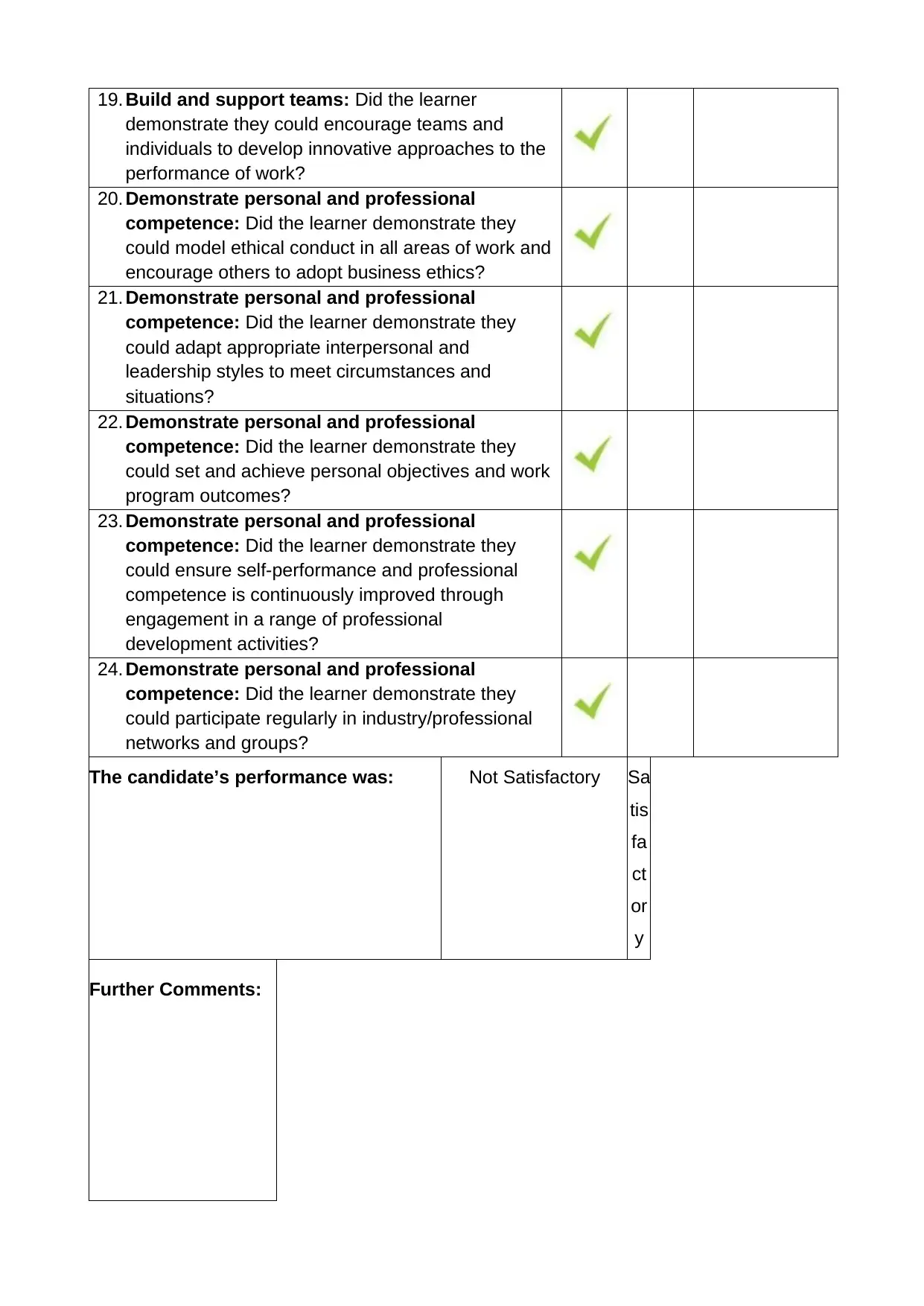
19. Build and support teams: Did the learner
demonstrate they could encourage teams and
individuals to develop innovative approaches to the
performance of work?
20. Demonstrate personal and professional
competence: Did the learner demonstrate they
could model ethical conduct in all areas of work and
encourage others to adopt business ethics?
21. Demonstrate personal and professional
competence: Did the learner demonstrate they
could adapt appropriate interpersonal and
leadership styles to meet circumstances and
situations?
22. Demonstrate personal and professional
competence: Did the learner demonstrate they
could set and achieve personal objectives and work
program outcomes?
23. Demonstrate personal and professional
competence: Did the learner demonstrate they
could ensure self-performance and professional
competence is continuously improved through
engagement in a range of professional
development activities?
24. Demonstrate personal and professional
competence: Did the learner demonstrate they
could participate regularly in industry/professional
networks and groups?
The candidate’s performance was: Not Satisfactory Sa
tis
fa
ct
or
y
Further Comments:
demonstrate they could encourage teams and
individuals to develop innovative approaches to the
performance of work?
20. Demonstrate personal and professional
competence: Did the learner demonstrate they
could model ethical conduct in all areas of work and
encourage others to adopt business ethics?
21. Demonstrate personal and professional
competence: Did the learner demonstrate they
could adapt appropriate interpersonal and
leadership styles to meet circumstances and
situations?
22. Demonstrate personal and professional
competence: Did the learner demonstrate they
could set and achieve personal objectives and work
program outcomes?
23. Demonstrate personal and professional
competence: Did the learner demonstrate they
could ensure self-performance and professional
competence is continuously improved through
engagement in a range of professional
development activities?
24. Demonstrate personal and professional
competence: Did the learner demonstrate they
could participate regularly in industry/professional
networks and groups?
The candidate’s performance was: Not Satisfactory Sa
tis
fa
ct
or
y
Further Comments:
Paraphrase This Document
Need a fresh take? Get an instant paraphrase of this document with our AI Paraphraser
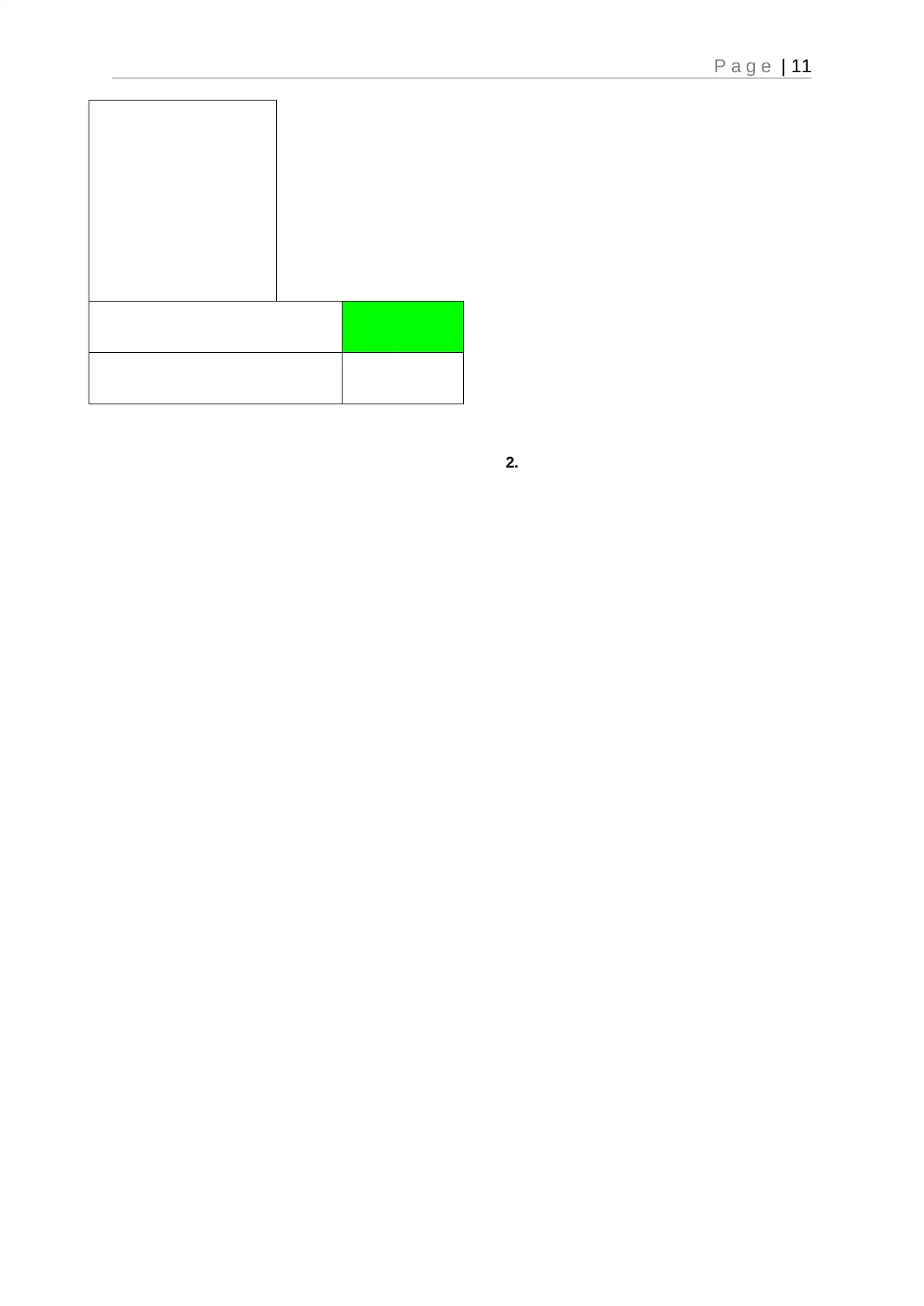
P a g e | 11
2.
2.
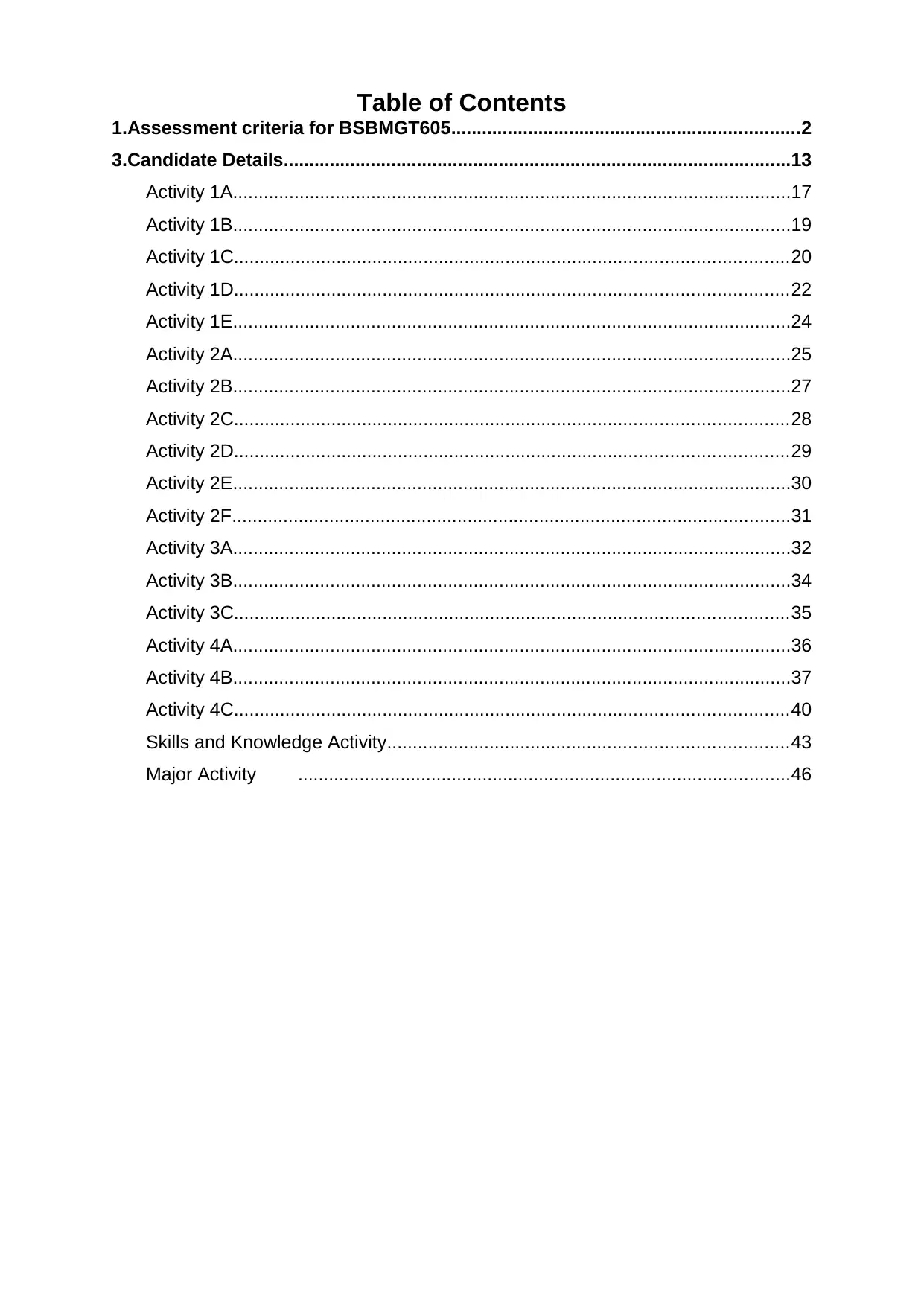
Table of Contents
1.Assessment criteria for BSBMGT605....................................................................2
3.Candidate Details...................................................................................................13
Activity 1A.............................................................................................................17
Activity 1B.............................................................................................................19
Activity 1C............................................................................................................20
Activity 1D............................................................................................................22
Activity 1E.............................................................................................................24
Activity 2A.............................................................................................................25
Activity 2B.............................................................................................................27
Activity 2C............................................................................................................28
Activity 2D............................................................................................................29
Activity 2E.............................................................................................................30
Activity 2F.............................................................................................................31
Activity 3A.............................................................................................................32
Activity 3B.............................................................................................................34
Activity 3C............................................................................................................35
Activity 4A.............................................................................................................36
Activity 4B.............................................................................................................37
Activity 4C............................................................................................................40
Skills and Knowledge Activity..............................................................................43
Major Activity ................................................................................................46
1.Assessment criteria for BSBMGT605....................................................................2
3.Candidate Details...................................................................................................13
Activity 1A.............................................................................................................17
Activity 1B.............................................................................................................19
Activity 1C............................................................................................................20
Activity 1D............................................................................................................22
Activity 1E.............................................................................................................24
Activity 2A.............................................................................................................25
Activity 2B.............................................................................................................27
Activity 2C............................................................................................................28
Activity 2D............................................................................................................29
Activity 2E.............................................................................................................30
Activity 2F.............................................................................................................31
Activity 3A.............................................................................................................32
Activity 3B.............................................................................................................34
Activity 3C............................................................................................................35
Activity 4A.............................................................................................................36
Activity 4B.............................................................................................................37
Activity 4C............................................................................................................40
Skills and Knowledge Activity..............................................................................43
Major Activity ................................................................................................46
⊘ This is a preview!⊘
Do you want full access?
Subscribe today to unlock all pages.

Trusted by 1+ million students worldwide
1 out of 52
Related Documents
Your All-in-One AI-Powered Toolkit for Academic Success.
+13062052269
info@desklib.com
Available 24*7 on WhatsApp / Email
![[object Object]](/_next/static/media/star-bottom.7253800d.svg)
Unlock your academic potential
Copyright © 2020–2025 A2Z Services. All Rights Reserved. Developed and managed by ZUCOL.





